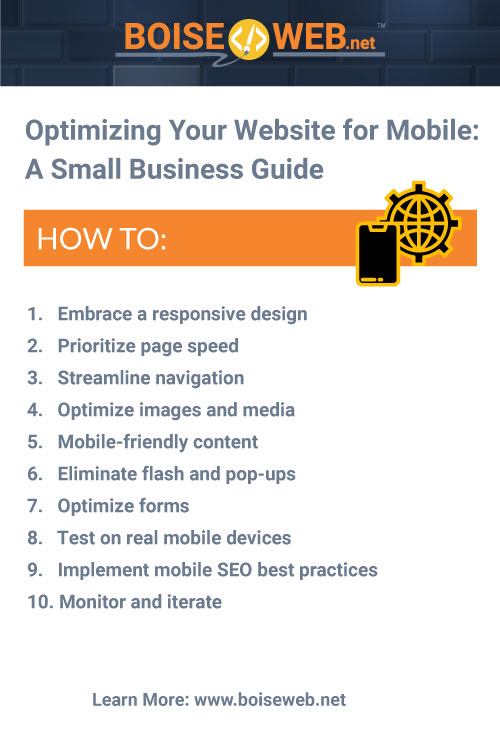With the majority of internet traffic coming from mobile devices, optimizing your website for mobile is no longer an option; it’s a necessity. Mobile optimization improves user experience and plays a significant role in search engine rankings. In this article, we’ll explore the importance of mobile optimization for small business websites and provide practical tips to help you get started.
- Embrace a responsive design
- Prioritize page speed
- Streamline navigation
- Optimize images and media
- Mobile-friendly content
- Eliminate flash and pop-ups
- Optimize forms
- Test on real mobile devices
- Implement mobile SEO best practices
- Monitor and iterate
How to Optimize Your Website for Mobile Users
In a world where smartphones and tablets have become extensions of our daily lives, optimizing your website for mobile users is no longer a luxury but a necessity. Mobile optimization ensures that your website is accessible, user-friendly, and visually appealing on a variety of mobile devices.
1. Embrace a Responsive Design
A responsive website design is the cornerstone of effective mobile optimization. Responsive design allows your website to adapt fluidly to different screen sizes and orientations. This means your site will look and function equally well on smartphones, tablets, and desktop computers. Google highly recommends responsive design, and it can improve your search engine rankings.
2. Prioritize Page Speed
Mobile users value speed. A slow-loading website can lead to high bounce rates and frustrated visitors. Optimize your site’s loading times by:
- Compressing images and other media to reduce file sizes.
- Enabling browser caching to store frequently used elements.
- Minimizing HTTP requests by combining CSS and JavaScript files.
- Using a content delivery network (CDN) to distribute content efficiently.
3. Streamline Navigation
Simplify your website’s navigation for mobile users. Consider implementing a mobile-friendly menu, such as a hamburger menu, to save screen real estate. Use clear and concise labels for menu items and ensure that links and buttons are large enough to tap easily. Keep the navigation structure simple to help users find what they’re looking for quickly.
4. Optimize Images and Media
Images and videos can significantly impact your website’s performance. To optimize for mobile users:
- Use image formats like JPEG or PNG for better compression and loading times.
- Implement lazy loading to load images only when they come into the user’s viewport.
- Ensure videos are HTML5-compatible and consider providing alternative formats for different devices.
5. Mobile-Friendly Content
Make sure your content is easily digestible on mobile devices:
- Use legible fonts and maintain an appropriate font size.
- Keep paragraphs short and concise, breaking up text with subheadings and bullet points.
- Minimize the need for pinch-to-zoom by ensuring text and images are appropriately sized.
6. Eliminate Flash and Pop-ups
Flash is not supported on many mobile devices, and intrusive pop-ups can disrupt the user experience. Avoid both and opt for HTML5 for multimedia content. If you must use pop-ups, make sure they are unobtrusive and easy to dismiss.
7. Optimize Forms
If your website features forms for contact, sign-ups, or purchases, optimize them for mobile users. Use mobile-friendly input fields, checkboxes, and buttons. Minimize the amount of typing required and consider implementing autofill options for common fields like names and email addresses.
8. Test on Real Mobile Devices
While testing on emulators is useful, it’s essential to test your website on actual mobile devices. This ensures that everything functions as expected and provides a real-world user experience. Test across various devices and operating systems to catch any potential issues.
9. Implement Mobile SEO Best Practices
Mobile optimization and search engine optimization (SEO) go hand in hand. Make sure your mobile site is optimized for search engines by:
- Using mobile-friendly metadata, including titles, descriptions, and headings.
- Ensuring your mobile site’s content and structure are search-engine-friendly.
- Monitoring your mobile search performance through tools like Google Search Console.
10. Monitor and Iterate
Optimization is an ongoing process. Continuously monitor your website’s mobile performance through analytics tools. Pay attention to user behavior, such as bounce rates and conversion rates, and make improvements based on data insights. Regularly updating and refining your mobile optimization strategy will help you stay competitive and meet evolving user expectations.
The Importance of Mobile Optimization
In the fast-paced business world, where digital transformation is the norm, small businesses must adapt or risk being left behind. One of the most pivotal adaptations they can make is to prioritize mobile optimization. Mobile optimization is no longer a luxury; it’s a necessity for small businesses.
The Mobile Revolution
The mobile revolution is in full swing, with smartphones becoming ubiquitous tools for communication, information, and commerce. Consider these compelling reasons why mobile optimization is crucial for small businesses:
Widespread Mobile Usage: Mobile devices have become the primary means through which people access the internet. According to Statista, in 2021, around 54% of all web traffic worldwide came from mobile devices. Small businesses that ignore mobile optimization miss out on a massive audience.
Local Search: Many consumers use their smartphones to search for local businesses, products, and services. Mobile optimization helps small businesses appear in these local search results, connecting them with potential customers in their vicinity.
E-commerce Growth: Mobile e-commerce, or m-commerce, is on the rise. Small businesses can tap into this lucrative market by ensuring that their websites are mobile-friendly. If shopping on your site is a hassle on a smartphone, you risk losing sales to competitors with better mobile experiences.
Search Engine Ranking: Google and other search engines prioritize mobile-friendly websites in their search results. Mobile optimization is a key factor in search engine optimization (SEO). Small businesses that neglect mobile optimization may find themselves buried in search engine rankings, making it challenging for potential customers to discover them.
User Experience Matters
User experience (UX) is a paramount consideration in web design, and it’s even more critical for mobile users. Here’s why:
First Impressions: Your website is often the first interaction potential customers have with your business. A mobile-friendly website creates a positive first impression, while a non-optimized one can deter visitors.
Navigation and Usability: Mobile users have different needs and expectations compared to desktop users. Mobile optimization ensures that your website is easy to navigate, with readable fonts, well-organized content, and intuitive touch-based interactions.
Load Times: Slow-loading websites frustrate users, leading to high bounce rates. Mobile optimization, including image and code optimization, can significantly improve load times on smartphones, keeping visitors engaged.
Competitive Advantage
In the crowded marketplace of the internet, small businesses need every advantage they can get. Mobile optimization can provide a competitive edge in several ways:
Brand Trust: Mobile optimization signals that your business is modern, tech-savvy, and cares about its customers’ experience. It builds trust with potential customers.
Reduced Bounce Rates: A mobile-optimized website keeps visitors on your site longer, reducing bounce rates. Visitors are more likely to explore your products or services, increasing the chances of conversion.
Higher Conversion Rates: An easy-to-use, mobile-friendly website encourages users to take action, whether it’s making a purchase, filling out a contact form, or signing up for a newsletter. This translates into higher conversion rates and increased revenue.
Adapt or Fall Behind
Mobile optimization is no longer a choice; it’s a fundamental requirement for small businesses. In a world where mobile devices dominate, small businesses must adapt to stay relevant. Mobile optimization not only enhances visibility in search results but also fosters trust, improves user experience, and drives higher conversion rates. Small businesses that invest in mobile optimization are better positioned to thrive in the digital age and remain competitive in an ever-evolving marketplace.
The author generated this text in part with GPT-3, OpenAI’s large-scale language-generation model. Upon generating draft language, the author reviewed, edited, and revised the language to their own liking and takes ultimate responsibility for the content of this publication.


